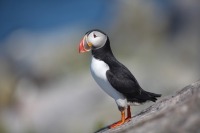
(Photo: Ralph Eldridge)
Atlantic Puffin
Fratercula arctica
The Atlantic puffin is a stout seabird with a black back and white underside and orange legs. Adults are around 26 to29 centimetres long with a wingspan of 47 to 63 centimetres. Puffins are easily recognizable by their large triangular bill. In breeding adults, this is bright black, orange, and yellow.
Authority
Linnaeus, 1758
Classification Details
Phylum: Chordata (chordates); Subphylum: Vertebrata (vertebrates); Class: Aves (birds).
Habitat
Atlantic puffins occur across the Atlantic, from Canada down to Maine in the west, and from Norway to Spain in the east. For most of the year puffins are found far our at sea feeding. From April to August, they come ashore to nest on islands. Puffins nest in large numbers in Canada, Scotland, Greenland, Norway and Iceland.
Diet
Puffins use their powerful wings to swim underwater and catch small fish around 5-15 centimetres long. They can dive up to 70 metres in pursuit of prey but usually feed shallower. Prey include sandeels, sprats, capelin, herring, hake and cod. They often capture several fish in one dive and hold them across their beak. Backward pointing spines on the roof of their mouth and toungue help keep the fish in place.
Reproduction
Puffins do not breed until they are 3-6 years old. They nest in colonies, often making burrows in soil at the top of steep cliffs. Atlantic puffins bond with one mate, often for life. The male attracts the female by flicking its head and grunting like a pig. The puffin pair dig their burrow with their feet and bills. They often come back and reuse the same burrow in following years. The female lays one egg which hatches after 36-45 days. The chick's parents brood it (sit on it in the nest) for nine days and feed it until it leaves the nest when 38-44 days old. Puffins can live for over 40 years.
Fun Facts
In the early 1900s, humans devestated North American puffin populations through habitat destruction and over hunting. Since then protective measures have allowed numbers to increase. Populations on Machias Seal Island in the Gulf of Maine have grown from just 60 birds in 1883 to 3,000 pairs in 1999.
The puffin's wings are much better for swimming than flying. In the air a puffin has to flap its wings 300-400 times per minute to stay airborn.
Baby puffins are known as 'pufflings'.
References
Audobon Atlantic puffin. Guide to North American Birds. https://www.allaboutbirds.org/guide/Atlantic_Puffin/ Accessed online 10 May 2021. Lowther PE, Diamond AW, Kress SW, Robertson GJ, Russell K, Nettleship DN, Kirwan GM, Christie DA, Sharpe CJ, Garcia EFJ, and Boesman PFD (2020). Atlantic Puffin (Fratercula arctica), version 1.0. In Birds of the World (S. M. Billerman, Editor). Cornell Lab of Ornithology, Ithaca, NY, USA. https://doi.org/10.2173/bow.atlpuf.01

